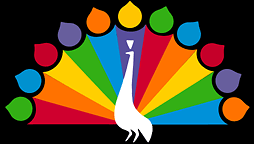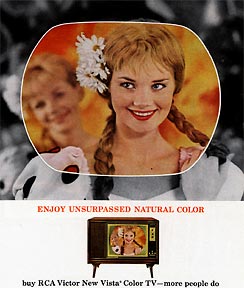  |
|
As television broadcasters and their audiences begin the massive and expensive transition to digital High Definition TV, you might be interested in the last major television revolution: the big change to COLOR broadcasting in the 1950s-60s. Until 1953 television had been strictly black and white. There were competing schemes for transmitting color pictures, but in 1953 the RCA "compatible-color" system was accepted as the standard by the FCC. RCA's system allowed color images to be transmitted and received on either monochrome or color receivers. But the RCA/NTSC Color Television System will soon be phased out because the FCC requires broadcasters to complete the changeover to digital transmission by 2007. There is a significant difference between the color revolution and digital/high definition revolution: RCA's NTSC system was accepted in 1953 because the new color broadcasts were compatible with the nation's millions of black and white receivers. Not so with digital broadcasting, which is transmitted over UHF frequencies and requires all new "ATSC" tuners to receive the digital signals which are not compatible with the RCA/NTSC system. The viewing public needed to make the switch to new digital TV sets, relatively inexpensive converters allow older TV's to view digital broadcasts.
In the 1950s and early 1960s, the RCA-owned NBC Television Network was virtually the only source for color broadcasts. CBS would broadcast an occasional color show, but many of their affiliates did not have color transmitters, so those rare broadcasts weren't even available for color viewing except in the largest TV markets. In 1965-66, when CBS and ABC finally threw in the towel and decided to join the color bandwagon, the push to convert the nation's broadcasters to color accelerated dramatically. To see more photos of NBC Color City in the 1950s - 60s, click here |
  |
Color TVs were expensive initially, and although manufacturers such as Zenith, Sylvania, and Admiral offered color sets, the majority were sold by RCA. Quite a windfall for RCA, considering they made the studio equipment that created the color images, owned the network that crafted color programming, the transmitters that broadcast the color signals, and most of the color TVs that received those signals. This is a 1964 magazine advertisement for To the many thousands of families buying color TV this week, here are facts to remember: RCA pioneered color television, made it a reality...made it dependable, proved it in homes like yours. RCA Victor introduced the High Fidelity Color Tube, proved in use to give you a picture up to 50% brighter than any previous color tube. You get unsurpassed natural color - color so clear, so bright you have to see it to believe it - plus the dependability of Space Age Sealed Circuitry. When you buy an RCA Victor, you buy the unparalled experience, advanced engineering and the extra care that adds value beyond price. Color TV prices start at $495 - manufacturer's nationally advertised price, optional with dealer - for Harper, not shown. (Trent model shown). Slightly higher some areas West, South. UHF optional extra. Prices, specifications subject to change. RCA Victor IS Color TV! |
|
See another large ad for RCA Big Color Television as seen in Collier's Magazine, November 1956 I get a lot of email from folks who have discovered my site. Thanks for the nice comments! Some visitors to this site remember an RCA color TV commercial from the early 1960's. Apparently the jingle in the commercial made a lasting impression because several folks have sent me the lyrics to the silly tune. Many thanks to David Johnson for sending me a video of the actual commercial to share with everyone. Most NBC affliliated television stations across the country were not owned by RCA-NBC. Until recently, the FCC allowed only 7 stations to be owned by the parent network. Hence all affiliates except for seven owned by each of the networks were independently owned and operated. The affiliates carry most of the network shows, but create their own locally originated programming as well. The expensive switch by NBC affiliates to local live, film, and tape color broadcasting occurred gradually beginning in 1954 through the mid-1960s. Local NBC stations were financially responsible for equipping their stations for color broadcasting. One of these NBC affiliates in 1962 was KSTP-TV, channel 5, Minneapolis-St. Paul, Minnesota. Its pioneering owner and founder, Stanley E. Hubbard, understood the need and value of converting his facility for local origination of color broadcasts. Naturally, RCA equipment was selected for KSTP, as they were the only manufacturer of color broadcasting equipment. RCA's monthly trade magazine "Broadcast News" ran a major story about KSTP's new color facility in the May 1962 issue. KSTP is still owned by Hubbard Broadcasting, although they are no longer an NBC affiliate, having switched to the ABC network in recent years. This feature in "Broadcast News" details the amazing KSTP "Television City" whose conversion to live color broadcasting rivaled many network operations and was no doubt one of the most advanced color studios in the U.S. in 1962. It was in this facility that my own prized TK-41 color television camera was in service for many years. I intend to restore the camera to pristine condition so that it will look as magnificent as it did when it's sparkling "Living Color" images were beamed throughout the Northwest. Take a tour of KSTP-TV in 1962 and see my TK-41 camera in service when it was new Visit my Color Television Home Page See videos of the original NBC peacocks and ABC and CBS color presentation logos See photos from my boyhood tour of KARD-TV in 1964 See photos of NBC Color City Studios in Burbank, California in 1955 See photos of my TK- 41 color television camera See an RCA 2" Color Television Tape Recorder See TK-40/41 photos along with video clips of TK-41's at work in TV studios See a video montage of an historic demonstration of the RCA compatible color system to the FCC See an excellent 1953 RCA brochure about the development of Color Television Watch the oldest surviving color videotape...the dedication of NBC's Washington, DC color studios in 1958 Watch An Evening With Fred Astaire the oldest surviving color videotape entertainment program (October 1958) Read the fascinating story of the restoration of "An Evening with Fred Astaire" Watch the oldest surviving videotape recording The Edsel Show - October 1957 Want to read more about early color television? Check out these links: Read NPR's coverage of color TV's 50th anniversary visit the late Ed Reitan's website - a very informative site about early color TV visit Bobby Ellerbee's fascinating and compreshensive television history website Eyes Of A Generation visit Chuck Pharis's site to see his collection of antique TV cameras and other early broadcast equipment visit Barry Mishkind's website to see the RCA Television Equipment Archive visit Steve Dichter's CT-100 website to see Steve's vintage color television page |
||
|
comments? send me an email
|
||
|
|
||
|
|

